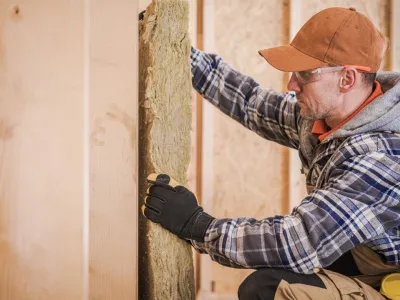High energy bills? Weatherization offers long-term solutions

Published February 7, 2022
As Minnesotans face the pressures of low temperatures and high natural gas bills this winter, significant support may be on the horizon. Efficiency upgrades to “weatherize” homes can help homeowners reduce their energy bills and, in turn, save money. With the passage of the Infrastructure Investment and Jobs Act, the federal Weatherization Assistance Program will receive approximately $3.5 billion in 2022. In contrast, only $315 million was available in 2021. This historic amount of funding is projected to allow more than 700,000 low-income households to be weatherized nationally. If you are interested in making your home more comfortable while lowering your heating costs, applying for energy upgrades through the Weatherization Assistance Program is a great opportunity.
Male contractor adding insulation into home walls.The Weatherization Assistance Program (WAP) is a federal program that provides states with money to increase energy efficiency in low-income households, improve health and safety, and reduce the amount of money households spend on energy. Energy upgrades can include additional insulation, air leakage reduction, or furnace, boiler, and water heater repair or replacement. Successful projects can reduce annual energy costs by up to 30 percent. With such a large amount of federal funding available this year, more weatherization improvements than ever can be installed.
In Minnesota, weatherization assistance is available to both renters and homeowners who meet income guidelines. Eligible Minnesota households can apply by contacting their local service provider or by accessing the joint Energy and Weatherization Assistance application online. More details, including current eligibility guidelines, can be found on the Department of Commerce’s website.
In some instances, households may have to undergo “pre-weatherization” measures before being eligible for weatherization improvements. For example, in older homes, mold, asbestos, or lead paint might have to be removed before energy upgrades can be installed. To address this concern, the Minnesota legislature passed the Energy Conservation and Optimization (ECO) Act to include pre-weatherization funding in Minnesota’s Conservation Improvement Program (CIP). Under the ECO Act, utilities must set aside a certain percentage of their annual revenues for low-income programs and up to 15% of the utility’s low-income spending can be used to pre-weatherize homes. Implementing these measures helps ensure more households are eligible for weatherization assistance. Because CIPs are administered by individual utilities, you should reach out to your local electric or natural gas utility to see if you might be eligible.
As always, if you have any questions, feel free to contact us at 651-300-4701 or at info@cubminnesota.org.